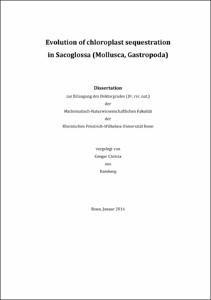Christa, Gregor: Evolution of chloroplast sequestration in Sacoglossa (Mollusca, Gastropoda). - Bonn, 2014. - Dissertation, Rheinische Friedrich-Wilhelms-Universität Bonn.
Online-Ausgabe in bonndoc: https://nbn-resolving.org/urn:nbn:de:hbz:5n-36517
Online-Ausgabe in bonndoc: https://nbn-resolving.org/urn:nbn:de:hbz:5n-36517
@phdthesis{handle:20.500.11811/6113,
urn: https://nbn-resolving.org/urn:nbn:de:hbz:5n-36517,
author = {{Gregor Christa}},
title = {Evolution of chloroplast sequestration in Sacoglossa (Mollusca, Gastropoda)},
school = {Rheinische Friedrich-Wilhelms-Universität Bonn},
year = 2014,
month = aug,
note = {Sacoglossa (Gastropoda, Panpulmonata) is a small taxon of marine gastropods with about 300 described species. It consists of two major lineages: the shelled Oxynoacea and the shell-less Plakobranchacea. The latter is sub-divided into the cerata-bearing Limapontioidea and the Plakobranchoidea characterized by so-called parapodia. Despite recent efforts phylogenetic relationships in Sacoglossa are not clarified thoroughly. Sacoglossa are mainly famous for their ability to incorporate functional kleptoplasts of their algae prey and to endure prolonged starvation periods with the help of the still photosynthesizing plastids, but the role of the food source to establish this peculiar relationship and how the slugs benefit from the sequestered plasJds is uncertain.
In this study the phylogenetic relationships of families in Sacoglossa based on four genes (28S, H3, COI, 16S), was analyzed. The monophyletic Oxynoacea is sister to the Plakobranchacea. In Plakobranchacea the Platyhedylidae is the first offshoot and the Limapontiodea as well as the Plakobranchoidea appear paraphyletic, although morphological data support their monophyly. Limapontiidae Costasiellidae and Hermaeidae are monophyletic, unlike the paraphyletic Polybranchiidae, where Cyerce is separated from the remaining taxa. Sister to the Plakobranchoidea is the Polybranchiidae without Cyerce. The monophyletic Boselliidae is sister to Plakobranchus and Thuridilla and together form the sister-clade to Elysia.
The ability to incorporate functional plastids also occurs in the genus Costasiella, the only Limapontiodea known for it so far. This affects the estimation of the evolution of functional kleptoplasty considerably. Currently two independent origins are the most likely scenario. A total of six species are identified to endure starvation periods for more than 20 days while keeping the plastids photosynthetically active, though probably there are more so-called long-term-retention forms that still need further investigation.
The molecular analysis of food sources was shown to be particularly important to clearly identify plastid origin. It provided evidence that plastids from certain algae are needed to establish functional kleptoplasty. However our results also show that unknown abilities of the slug are necessary as well, since non-retention forms also feed upon particular algae identified in long-term retention forms. Contrary to previous analyses, the slugs are not photoautotrophic, though harboring a photosynthetically active organelle. Starving experiments under non-photosynthetic conditions indicate that the reason of the survival of starvation periods may be that the plastids rather serve as food storage than as organelles for solar energy.
The results presented in this thesis were in some way surprising and therefore a change of the focus on the work of Sacoglossa with regard to functional kleptoplasty has become necessary. Plastid and slug physiology, as well as differences between non-retention and long-term-retention forms need to be investigated. The phenomenon of functional kleptoplasty remains fascinating and becomes partly even more challenging, which is why it deserves further detailed studies.},
url = {https://hdl.handle.net/20.500.11811/6113}
}
urn: https://nbn-resolving.org/urn:nbn:de:hbz:5n-36517,
author = {{Gregor Christa}},
title = {Evolution of chloroplast sequestration in Sacoglossa (Mollusca, Gastropoda)},
school = {Rheinische Friedrich-Wilhelms-Universität Bonn},
year = 2014,
month = aug,
note = {Sacoglossa (Gastropoda, Panpulmonata) is a small taxon of marine gastropods with about 300 described species. It consists of two major lineages: the shelled Oxynoacea and the shell-less Plakobranchacea. The latter is sub-divided into the cerata-bearing Limapontioidea and the Plakobranchoidea characterized by so-called parapodia. Despite recent efforts phylogenetic relationships in Sacoglossa are not clarified thoroughly. Sacoglossa are mainly famous for their ability to incorporate functional kleptoplasts of their algae prey and to endure prolonged starvation periods with the help of the still photosynthesizing plastids, but the role of the food source to establish this peculiar relationship and how the slugs benefit from the sequestered plasJds is uncertain.
In this study the phylogenetic relationships of families in Sacoglossa based on four genes (28S, H3, COI, 16S), was analyzed. The monophyletic Oxynoacea is sister to the Plakobranchacea. In Plakobranchacea the Platyhedylidae is the first offshoot and the Limapontiodea as well as the Plakobranchoidea appear paraphyletic, although morphological data support their monophyly. Limapontiidae Costasiellidae and Hermaeidae are monophyletic, unlike the paraphyletic Polybranchiidae, where Cyerce is separated from the remaining taxa. Sister to the Plakobranchoidea is the Polybranchiidae without Cyerce. The monophyletic Boselliidae is sister to Plakobranchus and Thuridilla and together form the sister-clade to Elysia.
The ability to incorporate functional plastids also occurs in the genus Costasiella, the only Limapontiodea known for it so far. This affects the estimation of the evolution of functional kleptoplasty considerably. Currently two independent origins are the most likely scenario. A total of six species are identified to endure starvation periods for more than 20 days while keeping the plastids photosynthetically active, though probably there are more so-called long-term-retention forms that still need further investigation.
The molecular analysis of food sources was shown to be particularly important to clearly identify plastid origin. It provided evidence that plastids from certain algae are needed to establish functional kleptoplasty. However our results also show that unknown abilities of the slug are necessary as well, since non-retention forms also feed upon particular algae identified in long-term retention forms. Contrary to previous analyses, the slugs are not photoautotrophic, though harboring a photosynthetically active organelle. Starving experiments under non-photosynthetic conditions indicate that the reason of the survival of starvation periods may be that the plastids rather serve as food storage than as organelles for solar energy.
The results presented in this thesis were in some way surprising and therefore a change of the focus on the work of Sacoglossa with regard to functional kleptoplasty has become necessary. Plastid and slug physiology, as well as differences between non-retention and long-term-retention forms need to be investigated. The phenomenon of functional kleptoplasty remains fascinating and becomes partly even more challenging, which is why it deserves further detailed studies.},
url = {https://hdl.handle.net/20.500.11811/6113}
}






